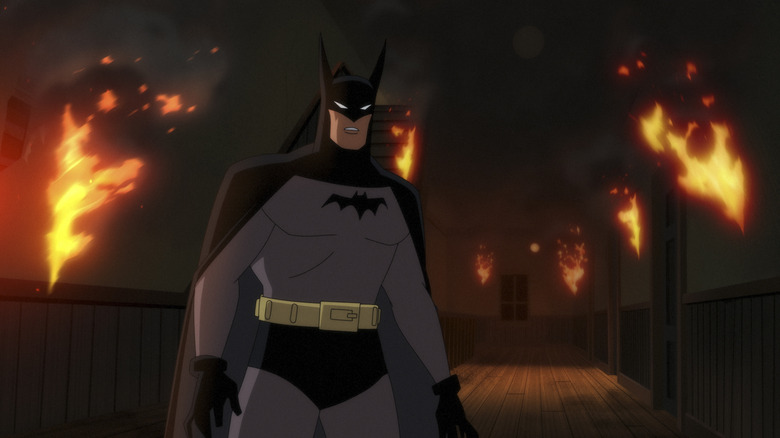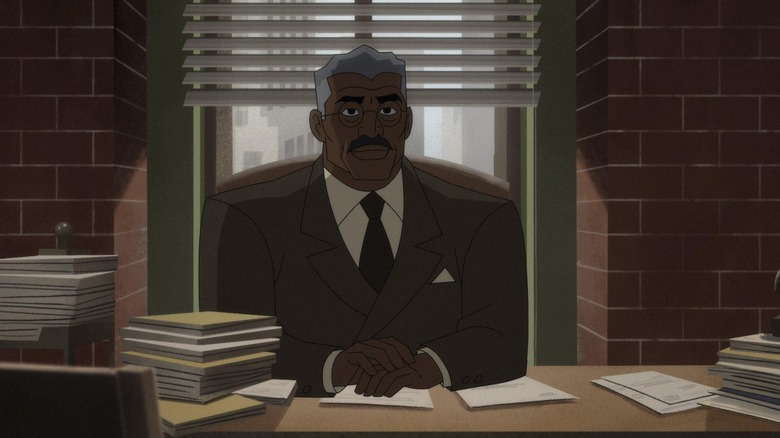I’ll only briefly touch on the corporate politics surrounding the release of “Batman: The Caped Crusader.” The new animated series, overseen by “Batman: The Animated Series” boss Bruce Timm and pop culture archbishop J.J. Abrams, was handed off to Amazon during David Zaslav’s infuriating selloff of Warner Bros. . Zaslav removed many popular shows from HBO Max (now simply “Max”), canceled seemingly sure-fire hits, and even set aside completed films for tax write-offs. Batman had a long association with Warner Bros. — the studio has released all Batman media since 1967 — so handing such a famous character over to another studio seemed like a financially foolish move to the world.
But in the end, these financial decisions are just paperwork, a mere obstacle in the way of a great series. And make no mistake, Caped Crusader is a great series. It’s a thoughtful, adult, intense, sometimes terrifying take on Batman that leans toward the classic. In the wake of the dark corporate auto-fellatio that was Deadpool & Wolverine, Caped Crusader is a breath of fresh air in that it attempts to tell a Batman story with creativity, care, and character. Rather than being a sweaty “love letter to the fans,” Caped Crusader engages viewers on an emotional level. And its key emotions are fear and guilt.
“Caped Crusader” isn’t meant to be consumed by fanboys with open notepads and vitriol-soaked Reddit accounts. It’s a dark, shadowy corridor to explore. A lucid nightmare of clowns and ghosts. It’s free of the teenage angst of Matt Reeves’ “The Batman,” and far enough removed from the bloated, wacky corporate antics of the DCEU. It’s the best Batman media of the decade.
Batman’s Big Shoes to Fill
But “Caped Crusader” comes with a lot of responsibility. In 1992, Bruce Timm oversaw “Batman: The Animated Series,” a stylistic continuation of Tim Burton’s “Batman” and “Batman Returns,” which came out in 1989 and 1991, respectively. That series was heavily stylized, depicting Batman as a five-foot-tall linebacker living in a film noir world shot with painful arrows. Burton strove to make his Batman movies feel timeless, as if they were set simultaneously in the present and the 1940s. Timm took that idea and expanded it into a beautiful-to-watch animated world. The series’ script was also sharp and mature, depicting its villains as wounded and complex, each of them touched by madness, obsession and resentment.
“Animated Series” was adored by an entire generation, and that generation, now adults, often considers it one of the best series of all time. One can agree or disagree with this generally accepted assessment, but there is no denying the place that Timm’s series occupies in the pop firmament.
“Caped Crusader” expands on the 1992 series in every way, establishing itself as the better series. The timelessness of “animated series” is now firmly rooted in the past, with “Caped Crusader” set in 1939, the year Batman first appeared on the page. Batman (Hamish Linklater) lives in a rundown Gotham City, still plagued by Depression-era poverty; “Caped Crusader,” even more than “The Dark Knight Rises,” explores Batman’s financial politics, emphasizing how poverty—and the lingering evil specter of inherited wealth—are directly tied to his feuds with villains.
Wealth and Evil in Batman: Caped Crusader
In “Caped Crusader,” for example, Catwoman (Christina Ricci) is a fallen socialite, frustrated that her once-rich lifestyle is coming to an end. This 1939 version of Selina Kyle is a spoiled, dandyish brat who turns to costumed cat burglary out of a sporting necessity to stay rich. The new Clayface (Dan Donohue) is a Lon Chaney-type actor whose oddball features have never gotten him mainstream Hollywood. In a fairly straightforward metaphor, one episode has Batman facing off against the Gentleman Ghost (Toby Stephens), a literal ghost with ties to land titles and dark magic. Batman must physically punch the generational accumulation of wealth in the face.
Other villains are more realistic. Firebug (Tom Kenney) is just an arsonist. Onomatopoeia (Reid Scott), wearing a strange mask, commands a team of hat-wearing gangsters. When he fights Batman, he mutters comic-book fight noises, an idea that could be an homage to William Dozier’s amazing 1966 “Batman” series. We all know the arc of Harvey Dent (Diedrich Bader), the character destined to become Two-Face. When he “splits” here (and I won’t reveal how), he’s not so much separating himself from good and evil as from hope and despair. This is a richer, more relatable version of the character.
A stern-faced Batman
The “Caped Crusader” version of Batman is deadpan and humorless. “I failed,” he says in his Batcave. “I can’t let that happen again.” He refers to Alfred (Jason Watkins) simply as “Pennyworth” and has no affection for the old man. When he’s in town as Bruce Wayne, he plays the “irresponsible playboy” role to a degree you know he hates. This Bruce Wayne is a brainless jerk, a wealthy millionaire who frustratingly survived the Great Depression without a scratch. He’s cheerful and friendly, but easy to hate. When he becomes Batman, he feels more at ease, simply because he’s more resolute.
The 1939 setting gives Batman’s investigations a more palpable, more tactile quality. It’s not all computer scanners and GPS. Batman has to go to the crime scene and prowl around looking for clues. When Batman gets too high-tech, he loses the haunted-house feel that should always surround the character. He’s a bat, after all. He should always be a little scary. When Batman is in a graveyard, he looks right at home. I’m beginning to understand why a goth like Tim Burton loved this character.
Batman’s Humans: Caped Crusader
Batman is balanced by a solid cast of ordinary human characters. Renee Montoya (Michelle C. Bonilla) is the only honest cop in the city. Barbara Gordon (Krystal Joy Brown) is a lawyer fighting a corrupt police force. Her father, the commissioner (Eric Morgan Stuart), seems weary and reluctant to give in to Gotham’s rampant crime. Voice actors John DiMaggio and Gary Anthony Williams play Gotham’s corrupt cops, happy to commit violence and bend the rules to their own advantage.
The 25-minute runtime of “Caped Crusader” forces the showrunners to be concise. The storytelling is tight and efficient. Characters move through arcs at a natural pace and aren’t forced to slow down for heavy action sequences or artificially extended periods of reflection.
There is an underlying sadness to “Caped Crusader” that makes it more adult than even a movie like “The Batman.” When a Batman movie or TV series focuses on “cool” or teenage self-pity (like in DECU or “The Batman”), the character becomes less interesting. On the other hand, when he becomes childish (like in 1966) or complex (like in 2024), the character excels.
In the year 2024, superhero media has seen several meltdowns. Vast, interconnected cinematic universes have long since supplanted characters and story, and some could be forgiven for abandoning the genre altogether. “Caped Crusader,” however, is a creative new take on Batman that reminds us why we are fundamentally drawn to hero characters in the first place. Sometimes, through sadness and anger, we must confront insurmountable corruption. It’s an incredible series.
/Movie rating 9.5 out of 10
All episodes of “Batman: Caped Crusader” will premiere on Prime Video on August 1, 2024.




